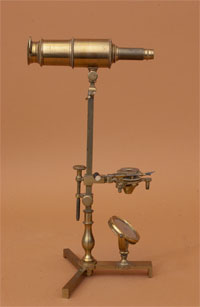 |
|||||
 |
 |
||||
 |
|||||
 |
 |
||||
Compound Microscope No. 38 |
||||||||||||
 |
||||||||||||
| Age: c1759 Made by: possibly Benjamin Martin Made in: England |
||||||||||||
 |
||||||||||||
 |
||||||||||||
|
Imaging
|
||||||||||||
|
This all-brass, compound monocular microscope is a relatively simple design, its body shape based roughly on that of the well-known Cuff instruments. The microscope body is supported by a single square pillar on a tripod base. The pillar is hinged at the top to allow the microscope to be rotated to the "aquatic" position (above right). Although it is not signed, a comparison with a known Martin Universal microscope, and the presence of a back objective lens suggests that this microscope in the Golub Collection was made by Benjamin Martin c1759. The microscope support base is a folding tripod with short leg extensions. The mirror is attached to one of the legs. Focusing is by a screw mechanism attached to the pillar. The lower focus mount is fixed to the support with a jam screw. The stage attaches to the upper mount. Turning the screw raises or lowers the sample stage. The cruciform stage is similar to the Cuff design and is equipped with a spring Bonanni slide holder. The eyepiece is a Ramsden, two-lens optical system. The optical element that makes this a probable Martin instrument is the "between-lens" found at the end of the objective snout. Martin's lens acted as the back objective element. This additional lens slightly reduced spherical and chromatic aberration, which allowed a larger objective aperture at any magnification. Martin added the between lens to all of his microscopes after its introduction in 1759. What places this microscope early in the Martin era is the presence of the Hevelius screw focus mechanism. Shortly after 1759 Martin replaced the screw-focus with rack and pinion focusing mechanisms on all his optical instruments. This microscope is approximately 33cm tall. The sample forceps is the only accessory with this instrument. However, the stage design accommodates a fish plate and glass live phial. Imaging resolution with the single objective is approximately 10x total magnification. Benjamin Martin (1714–1782) had his shop at 171 Fleet Street London, across the street from George Adams. There Martin made optical instruments, including telescopes, octants, and microscopes, and gave lectures on natural philosophy. His microscopes were equipped with the advances of the era: rack & pinion, multi-lens eyepiece, parabolic mirror. He introduced several innovations into compound microscope design—the most notable of which was the addition of a long focal length lens between the objective and field lenses. This "Between Lens" acted as the back objective lens, increasing the usable aperture and slightly increasing resolution. In addition, Martin was the first to use the term "Universal" to describe a microscope that can be used as a simple or compound microscope, in both the upright and "aquatic" (horizontal) position. Martin's contemporaries were Chevalier, Dollond, and Adams. In 1780 his son, JL Martin joined him at the firm, but by then B Martin and Son was in decline, and it declared bankruptcy shortly after. |
||||||||||||
| Featured 08/09, 03/2019 | ||||||||||||